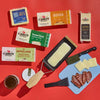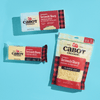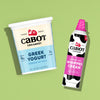
I'm Lactose Intolerant. Does That Mean I Should Avoid All Dairy?
Brierley Horton, M.S., RD is a dietitian nutritionist, content creator and strategist, and avid mental health advocate. She is co-host and co-creator of the Happy Eating podcast, which breaks down the connection between food and mental wellness.
Here’s the quick answer: no.
But there are some nuances. In other words, it’s a longer answer. Let’s discuss.
First, what is lactose intolerance? It means that you’re missing an enzyme called lactase which breaks down the lactose in some dairy products. Lactose is a sugar in milk and some other dairy products, and if you can’t digest it—either partially because you have some lactase still or fully because you have none—it can cause nausea, cramps, gas, bloating and diarrhea. Something else that’s important to know about lactose intolerance is, like its name implies, it’s a food intolerance, not a food allergy.
The challenging (err, unfortunate) thing about lactose intolerance is that there isn’t a treatment for it. You can manage your symptoms—aka avoid the negative repercussions—by making diet changes. So, what kind of dairy can you comfortably eat and what should you avoid?
Here are 4 diet tips if you have lactose intolerance:
Seek out aged cheeses.
All cheeses don’t always contain lactose. In the making of Cheddar, for example, the milk is separated into curds and whey, and the whey (where most of the lactose is) is drained from the curds. The curds are then pressed into blocks of cheese and any lactose remaining in the cheese is broken down in the natural aging process. Cheddar isn’t the only aged cheese that’s low in lactose—so are Colby Jack, Swiss, Parmesan, and more. Better yet, Cabot’s version of these cheese varieties contain zero grams of lactose per serving*.
There’s a super-simple way to identify a cheese with low to no lactose. Read the Nutrition Facts panel, and check the amount of sugar. If it reads zero grams or “0g” on the label, there is nearly no lactose in that cheese.

Go slow with yogurt, sour cream, and butter.
These dairy products are considered “low-lactose” foods. Butter, for example, is mostly fat so there’s very little sugar (aka lactose) in it. Yogurt, sour cream, and even kefir, are all low in lactose because they’re fermented dairy. The bacteria in these dairy products ferment a good amount of the lactose in the milk.
Skip milk and ice cream—maybe.
People with lactose intolerance can handle different amounts of lactose. Research suggests that many people could have 12 grams of lactose—the amount in about 1 cup of milk—without symptoms or with only mild symptoms. If you’re not sure how much you can tolerate, start with a very small serving. If you have a reaction, lactose intolerance symptoms will typically appear between a half an hour to a couple of hours after consuming the offensive food.
Add calcium and vitamin D in other ways.
If you avoid all milk and milk products, you may get less calcium and vitamin D than you need—and that’s because milk and milk products are the most common sources of calcium. Fortunately, there are other easy food sources of calcium: fish with bones (canned or fresh), leafy green vegetables like broccoli, tofu, Brazil nuts, almonds, and beans.
Our Favorite Nearly Lactose-Free Recipes
*We want you to feel confident about enjoying our award-winning cheddar. When we use the terms 'lactose free' or '0g of lactose per serving', it is because Cabot Cheddars, Monterey Jack, Colby Jack, and Muenster cheeses contain very-little-to-no lactose per serving (less than 0.1 grams per 1oz serving).
For reference:
1 8oz glass of milk has 12-13 grams of lactose
3/4 cup Greek yogurt has 4 grams of lactose
2/3 cup of Ice Cream has 4-5 grams of lactose
1 oz Cabot Cheddar has LESS than 0.1 grams of lactose















